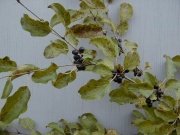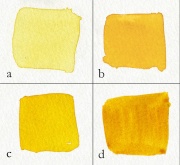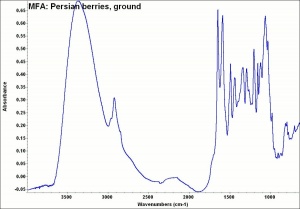Difference between revisions of "Persian berries"
m (Text replace - "== Authority ==" to "== Sources Checked for Data in Record ==") |
m (Text replace - "\[http:\/\/cameo\.mfa\.org\/materials\/fullrecord\.asp\?name=([^\s]+)\s(.*)\]" to "$2") |
||
| Line 2: | Line 2: | ||
== Description == | == Description == | ||
| − | Persian berries, also called buckthorn berries, are small berries from any shrub of the buckthorn family, such as ''Rhamnus infectorius'', ''R. amygdalinus'', ''R.oleodies'', or ''R.alaternus''. Buckthorn plants are native to the near East and have been cultivated in Europe since Roman times. A water-soluble dye was extracted from the berries for use in textiles, wood stains and lake pigments. The unripe berries produce a yellow juice or sap that is used for dyeing cloth and for making a yellow pigment called sap green. The ripe berries were used to make Dutch pink, a yellow lake. The principle colorant, [ | + | Persian berries, also called buckthorn berries, are small berries from any shrub of the buckthorn family, such as ''Rhamnus infectorius'', ''R. amygdalinus'', ''R.oleodies'', or ''R.alaternus''. Buckthorn plants are native to the near East and have been cultivated in Europe since Roman times. A water-soluble dye was extracted from the berries for use in textiles, wood stains and lake pigments. The unripe berries produce a yellow juice or sap that is used for dyeing cloth and for making a yellow pigment called sap green. The ripe berries were used to make Dutch pink, a yellow lake. The principle colorant, [[rhamnetin|rhamnetin]], is extracted from the dried berries by boiling water. Some plants also contain other colorants such as kaempferol (''R.cartharticus''), quercetin, xanthorhamnin, and emodin. Sap green lake is made with alum and can vary in color from yellow to green. On wool, Persian berries produce a golden color when mordanted with chrome and a dull yellow color with an aluminum mordant. A fugitive yellow color prepared on [[alumina%20trihydrate|alumina trihydrate]]was widely used in house paints in England in the 18th century. |
[[File:01_Buckthorn comp.jpg|thumb|Dye mixtures from | [[File:01_Buckthorn comp.jpg|thumb|Dye mixtures from | ||
Revision as of 11:14, 10 May 2016
Description
Persian berries, also called buckthorn berries, are small berries from any shrub of the buckthorn family, such as Rhamnus infectorius, R. amygdalinus, R.oleodies, or R.alaternus. Buckthorn plants are native to the near East and have been cultivated in Europe since Roman times. A water-soluble dye was extracted from the berries for use in textiles, wood stains and lake pigments. The unripe berries produce a yellow juice or sap that is used for dyeing cloth and for making a yellow pigment called sap green. The ripe berries were used to make Dutch pink, a yellow lake. The principle colorant, Rhamnetin, is extracted from the dried berries by boiling water. Some plants also contain other colorants such as kaempferol (R.cartharticus), quercetin, xanthorhamnin, and emodin. Sap green lake is made with alum and can vary in color from yellow to green. On wool, Persian berries produce a golden color when mordanted with chrome and a dull yellow color with an aluminum mordant. A fugitive yellow color prepared on alumina trihydratewas widely used in house paints in England in the 18th century.
Synonyms and Related Terms
Natural Yellow 13; buckthorn berries; dyer's buckthorn; bayas persas (Esp.); graine d' Avignon (Fr.); nerprun des teinturiers (Fr.); giallo di spincervino (It.); giallo d'avignone (It.); Gelbbeere (Deut.); Spincervino (It.); Espino cerval (Esp.); persische bessen (Ned.); bagas de Avignon (Port.); French berries; Persian berry lake; yellow berries; sap green; Avignon berries; Dutch pink; Dutch yellow; rhamnetin; kaempferol; kampherol; Rhamnus infectorius, Rhamnus amygdalinus, Rhamnus oleodies, or Rhamnus alaternus
Other Properties
Rhamnetin is soluble in sulfuric acid giving a greenish blue fluorescence. Slightly soluble in ethanol, acetic acid. Soluble in alkalis forming a brown solution. Decomposes in strong acids.
Additional Information
° J.Hofenk-de Graaf, Natural Dyestuffs: Origin, Chemical Constitution, Identification, Central Research Laboratory for Objects of Art and Science, Amsterdam, September 1969.
Sources Checked for Data in Record
- R. J. Gettens, G.L. Stout, Painting Materials, A Short Encyclopaedia, Dover Publications, New York, 1966
- Helmut Schweppe, Schweppe color collection index and information book
- Hermann Kuhn, Conservation and Restoration of Works of Art and Antiquities, Butterworths, London, 1986
- R. Newman, E. Farrell, 'House Paint Pigments', Paint in America , R. Moss ed., Preservation Press, New York City, 1994
- Thomas B. Brill, Light Its Interaction with Art and Antiquities, Plenum Press, New York City, 1980
- F. Crace-Calvert, Dyeing and Calico Printing, Palmer & Howe, London, 1876
- Colour Index International online at www.colour-index.org
- Judith Hofenk-de Graaff, Natural Dyestuffs: Origin, Chemical Constitution, Identification, Central Research Laboratory for Objects of Art and Science, Amsterdam, 1969
- Art and Architecture Thesaurus Online, http://www.getty.edu/research/tools/vocabulary/aat/, J. Paul Getty Trust, Los Angeles, 2000


